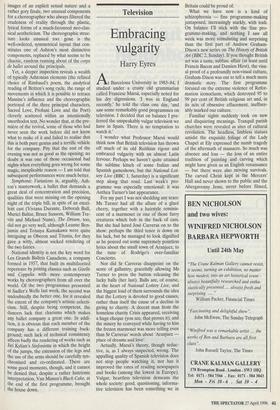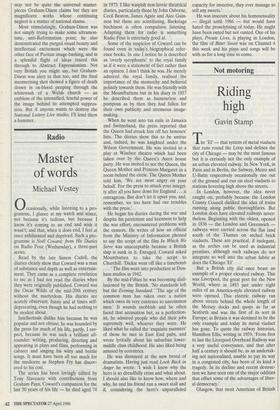Television
Embracing vulgarity
Harry Eyres
ABarcelona University in 1983-84, I studied under a crusty old grammarian called Francesc Marsa, especially noted for his dry digressions. 'I was in England recently,' he told the class one day, 'and saw some remarkably good programmes on television. I decided that on balance I pre- ferred the unspeakably vulgar television we have in Spain. There is no temptation to watch it.'
I wonder what Professor Marsa would think now that British television has thrown off much of its old Reithian rigour and embraced vulgarity with an almost Latin fervour. Perhaps we haven't quite attained the sublime kitsch of some Italian and Spanish gameshows, but the National Lot- tery Live (BBC 1, Saturday) is a significant step along that road. Last week's pro- gramme was especially emotional: it was Anthea Turner's last appearance.
For my part I was not shedding any tears: Ms Turner had all the allure of a glace cherry, together with a hairstyle reminis- cent of a marmoset or one of those furry creatures which bob in the back of cars. But she had lured Jose Carreras on to the show: perhaps the third tenor is down on his luck, but he managed to look dignified as he poured out some supremely pointless lyrics about the small town of Aranjuez, to the tune of Rodrigo's over-familiar Concierto.
Nor did Sr Carreras disappoint on the score of gallantry, gracefully allowing Ms Turner to press the button releasing the lucky balls (her last). Balls are, of course, at the heart of National Lottery Live, and the biggest load of them surrounds the idea that the Lottery is devoted to good causes, rather than itself the cause of a decline in giving to charity. A decent man from the homeless charity Crisis appeared, receiving a huge cheque (you see, that proves it), and the misery he conveyed while having to kiss the frozen marmoset was more telling even than Sr Carreras' words about Aranjuez place of dreams and love'.
Actually, Marsa's theory, though seduc- tive, is, as I always suspected, wrong. The appalling quality of Spanish television does not stop people watching it, nor has it improved the rates of reading newspapers and books (among the lowest in Europe). Vulgar, heartless television demeans the whole society: good, questioning, informa- tive television has been something we in Britain could be proud of.
What we have now is a kind of schizophrenia — fine programme-making juxtaposed, increasingly starkly, with tosh. On balance I'll stick with the fine pro- gramme-making, and nothing I saw all week was more stimulating and surprising than the first part of Andrew Graham- Dixon's new series on The History of British Art (BBC 2, Sunday). If you thought British art was a tame, subfusc affair (at least until Francis Bacon and Damien Hirst), the visu- al proof of a profoundly non-visual culture, Graham-Dixon was out to tell a much more dramatic story. The first programme focused on the extreme violence of Refor- mation iconoclasm, which destroyed 95 to 99 per cent of British religious art and, in its acts of obsessive effacement, inefface- ably marked our culture.
Familiar sights suddenly took on new and disquieting meanings. Tranquil parish churches were revealed as sites of cultural revolution. The headless, limbless statues amidst the exquisite foliage of the Lady Chapel at Ely expressed the numb tragedy of the aftermath of massacre. So much was absence and loss — the loss of an entire tradition of painting and carving which might have given us an English renaissance — but there were also moving survivals. The carved Christ kept in the Mercers' Hall and never shown to the public and the Abergavenny Jesse, never before filmed, may not be quite the universal master- pieces Graham-Dixon claims but they are magnificent works whose continuing neglect is a matter of national shame.
Most stimulatingly, Graham-Dixon was not simply trying to make some ultramon- tane, anti-Reformation point; he also demonstrated the purged visual beauty and intellectual excitement which were the other face of Puritan image-bashing, and in a splendid flight of ideas traced this through to Abstract Expressionism. Not very British you might say, but Graham- Dixon was alert to that too, and the final mesmerising shot showed a figure of death drawn in ox-blood peeping through the whitewash of a Welsh church — an emblem of the intensified, fearful power of the image behind its attempted suppres- sion. But if anyone wants to destroy the National Lottery Live studio, I'll lend them a hammer.



























































 Previous page
Previous page